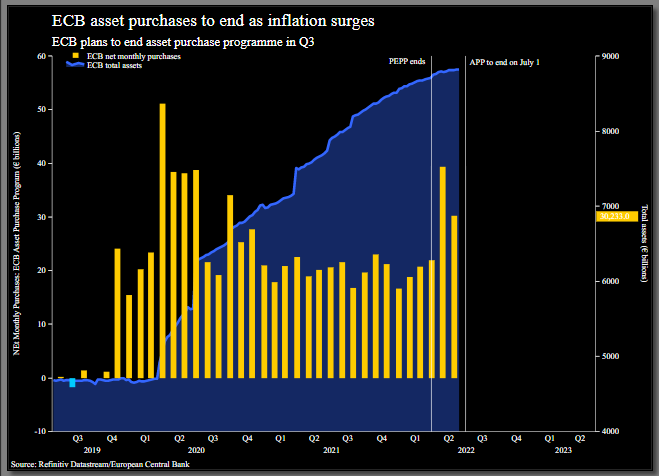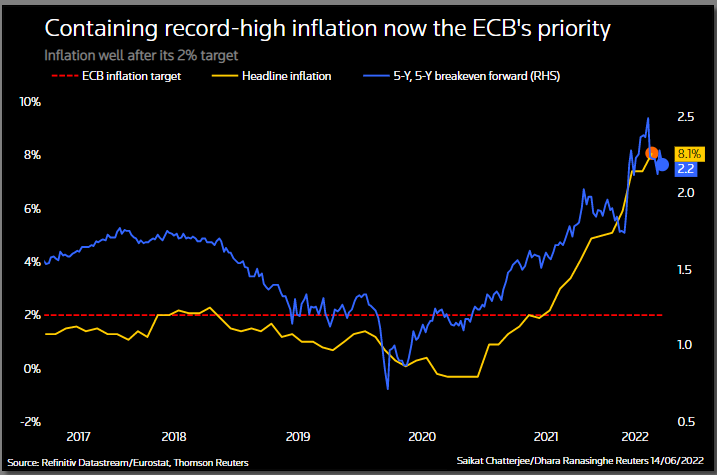The premiums investors demand to hold bonds from Italy, Spain and Portugal over safer German debt – spreads in market parlance – have reached their highest level since 2020. With the key ECB interest rates rising by 75 basis points over the next three months, Italian and Spanish 10-year borrowing costs have risen to eight-year highs.
So far, the ECB says it sees no need for new tools to help these weaker, highly indebted economies cope with rising interest rates. But widening spreads have investors wondering when and what the ECB might step in to contain so-called fragmentation risks.
“There is no easy solution,” said Frederik Ducrozet, head of macroeconomic research at Pictet Wealth Management. “We are here today because of the absence of a decision over the past six months.”
Here are some options for the ECB:
1. Do nothing
With inflation skyrocketing, that seems to be the current position.
The 10-year yield spread between Italy and Germany is 250 basis points, which markets previously viewed as a pain threshold for the ECB.
But sources told Reuters after last Thursday’s ECB meeting that politicians did not believe current conditions amounted to ‘fragmentation’ and there was no debate over a new program. .
“The very fact that the topic has not been discussed, in any form, has signaled to the market that the tolerance threshold is much further away than we previously thought,” said Rohan Khanna, strategist at UBS. .
What is the ECB’s pain threshold on the Italy/Germany bond spread? – Difference between Italian versus German 10-year bond yields, the 250 basis point threshold can be considered a crucial level
2. Be smart
The only tool the ECB has put in place so far is to reinvest maturing bonds bought as part of pandemic-era stimulus back into troubled markets.
But when spreads widened in April and May, it did not steer reinvestments into Southern European debt.
Societe Generale estimates that over the coming year the ECB will receive 300 billion euros ($314 billion) from repayments from its emergency PEPP plan. But she doesn’t think that can contain the widening of spreads.
Even if the ECB reinvests the entire flow of German and French bonds into Italy – around €12 billion per month – this will be less than the ECB’s net purchases of Italy by almost €14 billion per month. since March 2020, adds SocGen.

Net purchases of bonds by the ECB under the PEPP – By country in billions of euros
3. OMT and PMT?
The ECB certainly has other tools at hand, in particular the OMT (Outright Monetary Transactions) mechanism, an unused tool in times of crisis allowing the unlimited purchase of a country’s debt.
But economists doubt it will be rolled out, as it requires countries to sign a European Union bailout, which usually contains unpopular conditions.
Others believe it is more likely that the Securities Markets Program (SMP) will be revived. This facility would allow the ECB to buy bonds without adding to the stimulus measures already present in the system.
4. Bring out the EQ
If the rapid widening of interest rate differentials poses risks to the financial stability of the Union, the ECB could simply resume its asset purchases. But given that it has just ended bond purchases, that move seems unlikely.
It should be noted, however, that on March 18, when the COVID-19 outbreak pushed Italian-German bond spreads briefly above 300 basis points, the Bank of Italy stepped up its bond purchases to the ECB account.
Later in the day, the ECB launched its emergency PEPP program, which calmed the markets.
“The most obvious solution would be to relaunch the asset purchase program (APP), but that’s hard to do when you’re raising rates,” said Timothy Graf, head of State Street’s macro strategy for the EMEA region.

ECB asset purchases end soon – Monthly asset purchases (in yellow) and total ECB assets (in blue)
5. Something New
This may be why the idea of a new tool has gained ground, which would allow the ECB to target its bond purchases specifically on the weakest countries, departing from the usual principle. purchase of assets depending on the size of the economy.
However, such flexibility or a deviation from the “capital allocation key” could be a sticking point, especially on the part of the German Constitutional Court.
The ECB “knows that whatever it proposes, it risks ending up in the German Constitutional Court,” said Andrew Mulliner, head of global aggregate strategies at Janus Henderson.

The fight against inflation is the number one priority of the ECB – ECB inflation target (in red), Headline inflation (in yellow) and estimate of the level of inflation in 5 years (in blue, right axis )
